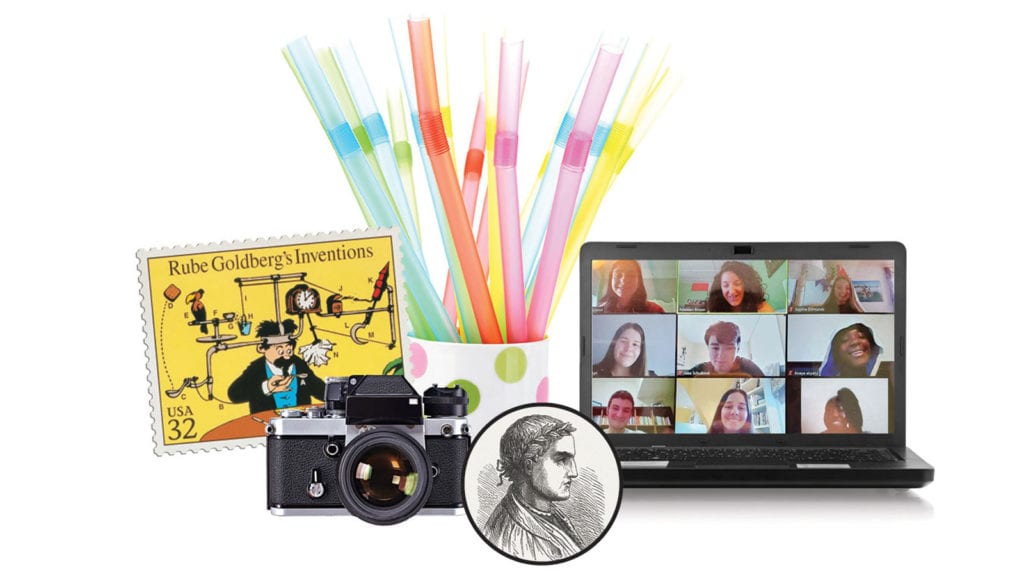With a mix of technology, innovation, and straight-up amazing teaching, Williston transitoned to online classes this spring. Here’s just a small sampling of the remote trimester that was anything but.
When the world went into social-distance mode, Williston was ready. As an international institution, we necessarily had been monitoring the coronavirus from shortly after it emerged. While hoping for the best, we began planning for the worst. In place of spring break, administration and faculty worked around the clock to take our robust academic experience completely online. Operating without benefit of a road map—at the beginning of March, relatively few people had ever heard of Zoom and no one at all knew what April or May would look like—we were guided by certain non-negotiable objectives. Advisories would continue to meet, assemblies would take place somehow, and above all, we’d continue to connect with and support students. Lectures, testing, and even the grading system might look different, but we were committed to upholding the quality of instruction. Thanks to Williston’s Curricular Technology Program, now in its seventh year, we were in a strong position to transition to remote learning.
But technology was only part of the story. What really made the online shift possible were the people—nimble teachers and open-minded students, who, putting very real sadness aside, embarked together on a trimester unlike any other. Here are some of the innovative techniques they rolled out in different subjects to bridge the miles.
1. The Home Lab
With Scott Hall off limits, science teacher Matt KaneLong instructed his ninth and 10th grade students to turn their homes into personal physics labs. In one grand experiment, they designed and constructed elaborate Rube Goldberg machines in their bedrooms, kitchens, and studies, then recorded the controlled mayhem as the contraptions poured water, opened books, or filled a dog’s bowl with ice cubes. “Building these machines is the ultimate hands-on application of the physics principle of conservation of energy,” KaneLong says. “Oh yeah, it’s also a lot of fun!” Director of Curriculum Kim Evelti also found ways to turn home confinement into a virtue. Throughout the spring, students in her computer science class beta-tested the apps they were writing on captive parents and siblings. The feedback helped them refine their inventions, which include a game where players vie to save endangered turtles by keeping plastic straws out of the ocean and an art program that lets users apply paint strokes and dabs to photographs.
2. Digital Meets Analog
In one of the more complex digital-analog mashups of the term, visual and performing arts teacher Edward Hing ’77 enlisted his students in a multi-stage photography experiment. He began by sending each one a film camera (a first for many) and a roll of film. Students took photographs and returned the exposed film to Hing, who developed it and sent the negatives back to students. They then used their laptops to shoot digital photos of the negatives. These they printed onto inkjet transparency film, which they developed by exposing to the sun. The resulting images were contact printed onto cyanotype paper, producing pictures of a deep Prussian blue. “I’ve gotten some cool results,” says Hing. Department Chair Natania Hume also found ways to mix traditional and digital techniques. In her drawing class, students made pencil drawings of still life scenes they set up in their homes, uploaded photos of their work onto OneNote—Williston’s collaborative notebook program—and took turns giving classmates constructive criticism by sharing their screens during a Zoom meeting. What surprised them about the remote studio critiques, reports Hume, is that “with just a pencil and printer paper, they could learn to draw.” Pencil, paper, laptop, broadband access, file-sharing software, and, it should be noted, a tirelessly dedicated group of teachers.
3. Collaborative Learning
In an extreme form of showing one’s work, Josh Seamon had students in his advanced Calculus class make instructional videos in which they led classmates step-by-step through homework problems. In order to teach the material, students had to really master it. Playing back the videos during class meetings served the added benefit of injecting a daily dose of variety into the online format. Department colleagues like geometry and pre-calculus teacher Kathryn Hill, meanwhile, became early adopters of Zoom’s breakout room feature, which allows large meetings to split up into smaller sections. The function enabled kids to continue with the collaborative, small-group learning that is a Williston hallmark even as they isolated at home.
4. Language and Literature
Ancient met contemporary in the online Latin classroom of Language Department Chair Beatrice Cody, who devised a vocabulary-building version of the game Pictionary that could be played using Zoom’s whiteboard feature. Students would sketch visual representations of words while classmates, playing along at home, took turns trying to decipher them. The uniquely Roman thing: All the examples came from an ode by Horace, the first century B.C.E. lyric poet. Over in the French department, teachers cooked up some unique exercises of their own. MTV met the Académie Française in Susan Michalski’s French 3 Honors class, where students used Flipgrid, a video chat platform, to record responses to moody French poems set to music. Adeleen Brown kept things lively by bringing in a guest Zoomer from the French-speaking country of Cameroon. “She shared images, music, and personal stories,” says Brown. Her students finished the trimester with panache, staging a virtual fashion show—a stylish way to practice clothing-related vocabulary.

